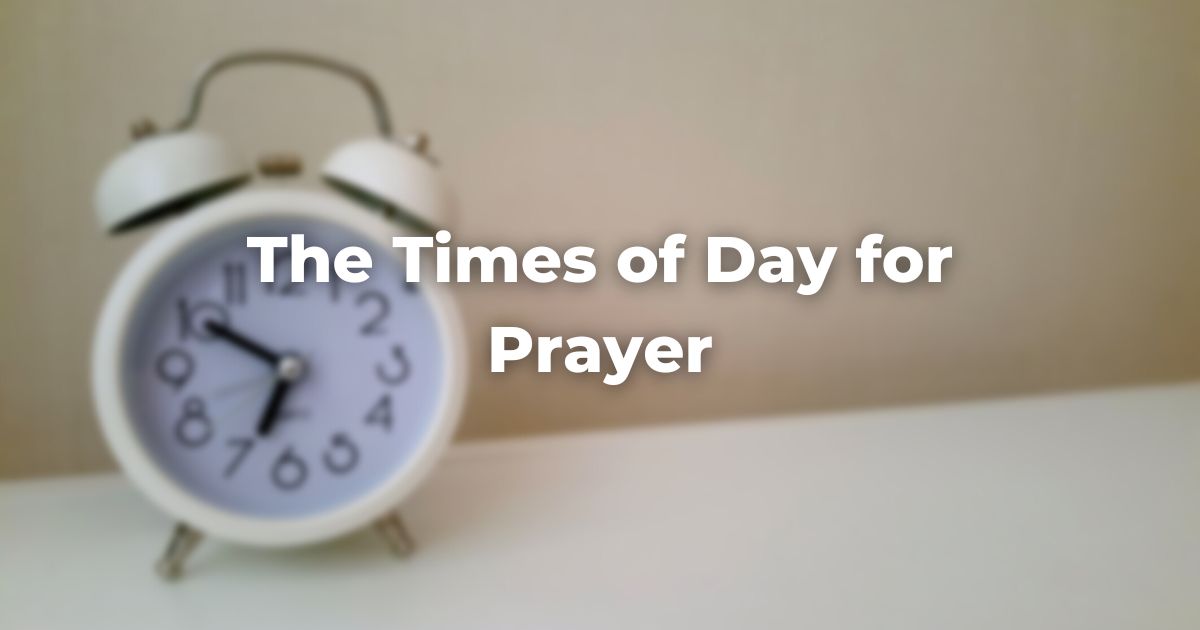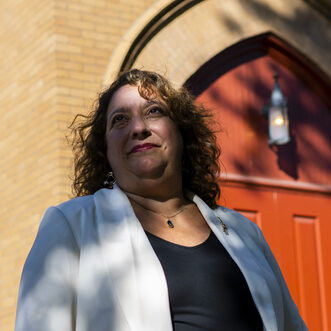There are three prescribed times of day for Jewish prayer: morning, afternoon, and evening.
One midrashThis word is used in two ways, as both a concept and a literature. As a concept, midrash is the expansive interpretation of biblical texts. The term is used to describe the practice of rabbinic interpretation. As a text, it refers to specific collections of interpretations, particularly from the third to ninth centuries in the Land of Israel and Babylonia. Plural: Midrashim
Read more preserved in the TalmudReferring to one of two collections, the Jerusalem and Babylonian Talmuds, edited in the 6th century, that contains hundreds of years of commentary, discussion, and exploration of the ideas in the Mishnah. One could describe it as Mishnah + Gemara = Talmud Read more (at BT Berakhot 26b) explains that the obligation to pray three times a day was instituted in honor of our three patriarchs, Abraham, Isaac and Jacob, each of whom inaugurated his own prayer service.
Abraham was moved to pray to God while gazing out at the ruins of Sodom in the morning. Isaac prayed out in the field upon noticing Rebecca’s approach in the afternoon light. Jacob prayed at nightfall when he lay down to sleep on the ground at the place later to be called Bethel.
When we say our prayers, we hope that we can achieve the deep intentional focus attained by our ancestors during their different moments of needful supplication.
Prescribed Times
When do these specific prayer periods fall?
The talmudic system supposes that the time between dawn and dusk is to be divided into twelve seasonal “hours.”
These seasonal “hours” vary in length throughout the year depending on how much time there is between sunrise and sunset. (The halachic “hour” in the winter will be much shorter than the halachic “hour” in the summer.)
According to this system, the period during which the morning Shema may be recited begins at sunrise and continues to the end of the third hour—that is to say, the first quarter of the day.
The morning Amidah, however, may be recited until the end of the fourth hour—that is, the first third of the day.
The afternoon Amidah may be recited after the onset of the first half of the seventh hour of the day until sundown.
The Evening Amidah may be recited throughout the night, beginning at sundown.
If it is unlikely that a minyan will gather after nightfall, the Evening Amidah may be recited even earlier than sundown, as long as the Shema is repeated later in the night.
Minimal Daily Prayer
The halakhah requires that a Jew pray three times a day, every day. However, it is inevitable that there will be times in every person’s life when it will simply be impossible to fulfill this obligation.
For that reason, the halakhah sets some minimal standards for daily prayer.
(These are not intended to provide a less arduous alternative to fulfilling the mitzvah in its fullest detail, merely to nod to the exigencies of daily life.)
For example, it is permissible to scale the Morning Service back to its barest minimum by reciting the morning blessings, Barukh She-amar that introduces the P’sukei D’zimra section, Ashrei, Psalms 148 and 150, Yishtabaḥ, and then proceeding with the Shema (also spelled the Sh’ma) and its opening and closing benedictions, the Amidah, and Aleinu. (This abridgement is based on SA Orach Chayim 52.)
For those mornings when time is so limited as to preclude the possibility of reciting the full Amidah, there is also a shortened version called Havineinu that can be recited.
This version incorporates the first three blessings of the standard Amidah, an abbreviated version of the intermediary thirteen blessings, and the full version of the three concluding blessings.
It is not permitted, however, to recite Havineinu during the months of the rainy season in Israel, when Jews worldwide include a prayer for rain in the Amidah.
Nor may one use the Havineinu option during the Evening Service following Shabbat or festivals (SA Orach Chayim 110:1).
The Afternoon and Evening Services, being so brief, may only be abbreviated by reciting the shorter version of the Amidah instead of the longer one.
Arriving Late to Communal Prayer
The halakhic sources also consider the issue of one who simply arrives in synagogue late in the service and is unsure what to omit in order to catch up to the rest of the community.
During the Morning or Afternoon Service, the rules are similar.
If one comes in and finds the community at prayer, one must estimate whether or not one will be able to begin and end the Amidah before the prayer leader is ready to recite the K’dushah (also spelled the Kedusha).
If one can, then one should immediately begin the Amidah. If not, one should wait until the prayer leader begins to repeat the Amidah, and then recite the prayer quietly, word for word, until the K’dushah. After joining in the K’dushah, one should finish one’s prayers quietly.
In the morning, one then recites the Shema.
If one errs in one’s estimation and, after beginning to recite the Amidah, then realizes the prayer leader will come to the K’dushah while one is still in the middle of one’s prayers, one should not participate in the K’dushah but should rather continue with one’s private recitation of the Amidah.
One should also not interrupt one’s prayers to respond to the prayer leader during Kaddish (Mishneh TorahRefers to the first five books of the Hebrew Bible, the Tanakh, also called the Five Books of Moses, Pentateuch or the Hebrew equivalent, Humash. This is also called the Written Torah. The term may also refer to teachings that expound on Jewish tradition. Read more, Prayer and the Priestly Blessing 10:16; cf. Shulchan Arukh, Orach Chayim 109:1–2).
Upon entering the synagogue to recite the Evening Service and finding that the congregation has already recited the Shema, one should join the congregation in the Amidah and then recite the Shema with its blessings afterward (SA Orach Chayim 236:3).
The basic rule is that when one arrives at synagogue and can join in a section that cannot be recited by an individual, participate in the communal prayer first, and then return to catch up on prayers that can be recited without a minyan.
This emphasizes the centrality of community in Jewish prayer without depriving the individual of the opportunity to recite their prayers fully.
Adapted with permission from The Observant Life.
Authors
-

Rabbi Dr. Karen G Reiss Medwed, is Teaching Professor emerita at Northeastern University. She serves as Interim Vice Provost, Academic Affairs and Initiatives for HUC-JIR. Dr. Reiss Medwed's scholarship includes digital education, higher education leadership, and faith-based education. Dr. Reiss Medwed was ordained by JTS in 1995, and earned her Ph.D. from New York University's Steinhardt School of Education in Curriculum, Teaching and Learning with a specialization in Jewish education in 2005.
View all posts -

The Observant Life: The Wisdom of Conservative Judaism for Contemporary Jews distills a century of thoughtful inquiry into the most profound of all Jewish questions: how to suffuse life with timeless values, how to remain loyal to the covenant that binds the Jewish people and the God of Israel, and how to embrace the law while retaining an abiding sense of fidelity to one’s own moral path in life. Written in a multiplicity of voices inspired by a common vision, the authors of The Observant Life explain what it means in the ultimate sense to live a Jewish life, and to live it honestly, morally, and purposefully. The work is a comprehensive guide to life in the 21st Century. Chapters on Jewish rituals including prayer, holiday, life cycle events and Jewish ethics such as citizenship, slander, taxes, wills, the courts, the work place and so much more.
View all posts







